How to scale content marketing for your Startup?
This article will detail how Back4App increased organic traffic from 8k users/month to 100k users/month in less than 24 months. In addition, we will provide real-life guidelines based on our own experience scaling marketing content.
Contents
- 1 Key Takeaways
- 2 We scaled our traffic 12x and you can do it too
- 3 Top 10 real-life practical lessons to scale up marketing content
- 3.1 1. Define a publishing pace and stick to it
- 3.2 2. Write quality content and keep It updated
- 3.3 3. SEO tools are very important
- 3.4 4. Focus on long-tail and easy to rank key words
- 3.5 5. Translating your content is cheap and works like a charm
- 3.6 6. Site speed really matters to Google
- 3.7 7. Backlinks, of course, help, but you can rank without them
- 3.8 8. Easy to implement tactics to get backlinks
- 3.9 9. Technical SEO is very important
- 3.10 10. Find a marketing guru to follow
- 4 Conclusion
- 5 FAQ
- 6 How to scale content marketing for a startup?
- 7 What is the fastest way to rank on Google?
- 8 Is page speed really important for Google?
Key Takeaways
- Writing quality content is a must, but not enough
- It’s possible to scale marketing content without backlinks or social media posts
- I’m not a marketer and had no previous experience creating content
- No need for a full time marketing person, and you can outsource most of the tasks
- We started creating content with only a $100/month budget
Intriguing and hard to believe, right?
We scaled our traffic 12x and you can do it too
Here is a print screen from Google Analytics showing our traffic over time. That’s is how our Google Analytics dashboard looked like in January 2020. A total of 7,936 organic users.
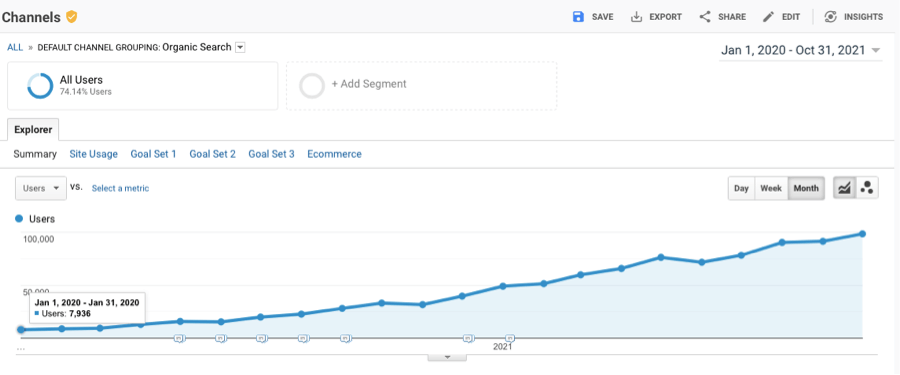
That’s is how our Google Analytics dashboard in October 2021. A total of 98,512 organic users.
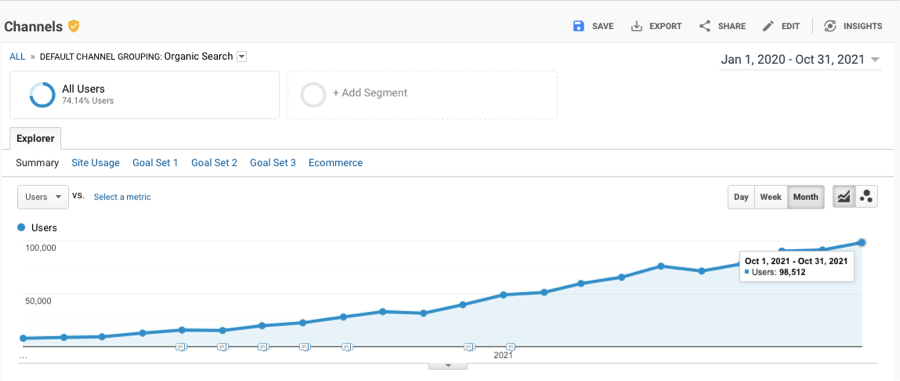
That is a 12x increase in less than 24 months. Not bad, right? Keep reading to know more.
Top 10 real-life practical lessons to scale up marketing content
I will reveal the hidden secrets of scaling content marketing and provide practical steps based on my own experience with Back4app’s blog.
1. Define a publishing pace and stick to it
Believe it or not, this is the single most crucial step on this list. Creating content must be part of your routine! Imagine how much you can write after 365 days!
The amount of time you invest to produce content depends on the size of your organization and your marketing budget. For example, I invest around 4 hours/day to monitor all the content and prioritize marketing tasks.
On Back4app, the pace to publish articles on our blog is one article per day. Monday to Sunday, and including holidays. There is no need to work all these days, but you can schedule the articles on Word Press.
You can choose your own pace based on your resources and how much time you have available for this activity. There is no need to publish articles daily, but it is imperative to have a routine and stick to it. You can start doing it weekly (or monthly) and increase the pace accordingly.
During June 2019 and December 2019, we published multiple articles, but barely without any result. The needle just moved from 5k monthly users to 7k monthly users. It was very frustrating and not encouraging at all.
It may take between 6 months to 12 months for Google to rank your articles on the first page. So please don’t give up and keep publishing great content.
It’s hard for everybody, and eventually, you will rank. I will explain on the following topic some tactics that may speed up and facilitate this process.
The real growth only came after defining a pace and sticking to it for a long time. We started with one article per week and eventually increased to one article per day.
2. Write quality content and keep It updated
Unless your content is excellent (or at least good), it will not move the first page. So do your best that your content plan covers a specific niche and create as many articles about that topic.
Diversification is good for investments but not for increasing organic traffic. So, choose the type of content you publish wisely. Try to focus on the problem your product or service solves every time you create pieces of content. Use examples, case studies, etc., to engage the audience and increase trust.
At Back4app, the kind of content we write about is technology, and our potential customer is a startup developer. So we are now laser focusing on writing articles that solve problems and attract developers who work for startups.
The more laser focus you have, the better. Don’t try to write about technology and Italian food on the same blog. It will not work, and most likely, Google will not rank you on either topic.
The other aspect that is as important as writing quality content is to keep the content up to date. Unfortunately, as soon as the number of articles grows, this task becomes time-consuming and hard to accomplish.
The strategy we use at Back4app is the Pareto principle. Considering that we do not have the resources to keep the entire blog updated, we focus on 20% of the articles that bring 80% of the traffic. Not ideal, but it works well.
Here is an excellent example of how important it is to update the content. Here are the metrics of the article Firebase – All secrets unlocked. The article was updated in February 2021, and by April, the traffic almost tripled.
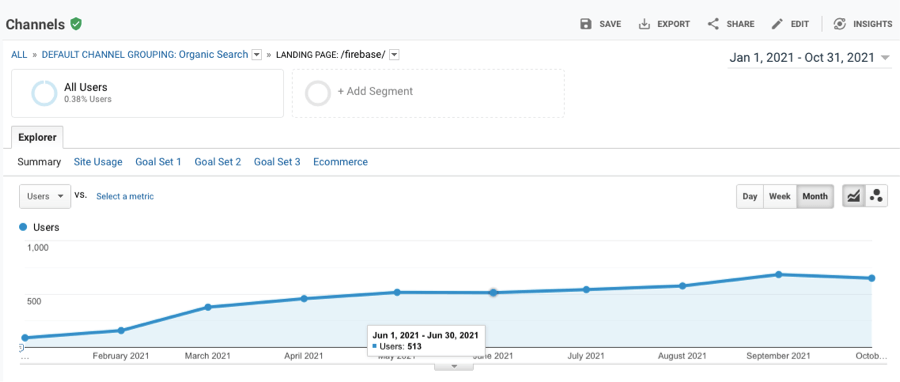
3. SEO tools are very important
There is too much competition today, and blog posting without proper tools will make your life quite hard. As you will see below, targeting the right keywords is extremely important to rank well.
At Back4app, we use the following tools:
- SemRush
- CopyScape
- Google Analytics
- Amplitude
SemRush is a comprehensive SEO tool and will provide you with keyword research, SEO dashboard, link building, and site audit. It’s easy to get addicted to it, and now it’s hard to live without it. The only downside of the SemRush is that it is expensive. Pricing starts at $119.95/month.
Other similar tools you can try are ahrefs, Moz, and Ubersuggest. From these three, I only tried Moz and Ubesuggest (which are great tools and less expensive than SemRush), but I never tried ahrefs.
CopyScape is a must-have to avoid plagiarism on your blog. Make sure you test all the articles on CopyScape before publishing them. It will highlight if your content is original or not. It is improbable you will rank on Google having a copied article on your blog. So, make sure all content is original.
We use Google Analytics to monitor website traffic, acquisition channels, and bounce. I will not explore the benefits of this tool in detail, and if you want to know more, please refer to Beginners Guide of Google Analytic.
In addition to Google Analytics, we also use Amplitude. The core difference between these tools is that Google Analytics focuses on traffic (page views, sessions, etc.), and Amplitude tracks events.
For example, Amplitude is a must-have tool to track registrations on the website correctly. For more information about the differences, please refer to the article GA vs. Amplitude. The good news is that Amplitude has a very generous free tier.
4. Focus on long-tail and easy to rank key words
Ranking on the first page for head / high-competitive keywords is extremely hard, and most likely, only large brands will be able to do that. Focusing on low-competitive / long-tail keywords will make your life easier, and you will get traffic faster.
Here are some easy-to-understand examples.
Let’s consider the article How to make an app. According to SemRush, the keyword “how to make an app” has 73,6k searches per month, is very competitive (80 out of a 100 scale), and the URL should have 349 backlinks to rank on the first page.
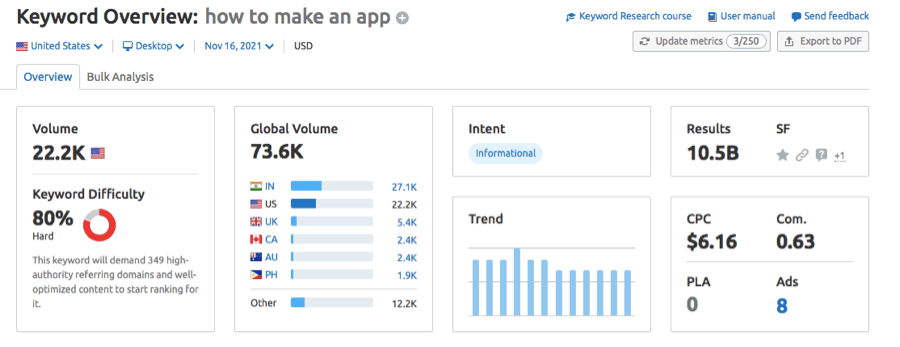
I invested around 40 hours writing the content. The article provides in-depth guidelines related to Back4app’s niche, but it got very little traffic because of the competition. Metrics below:
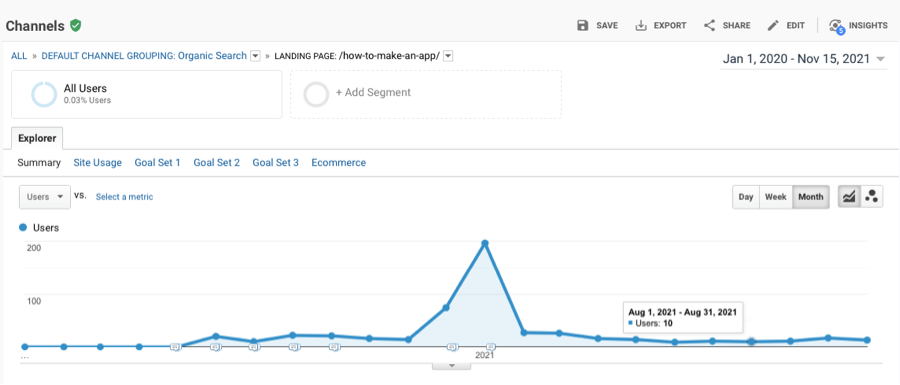
The article got only 510 users between January 2020 and November 2021. That’s is an awful result considering the total time invested and the content quality.
The reason for that is simple. Although the content is excellent, there is a ton of competition for this exact keyword and other websites with more authority for this topic.
Simply put, creating this article did not generate ROI and was not an intelligent allocation of my time (I wrote this one and did not outsource) and money.
Now, let’s take a look at the article How to make an app like Facebook. It is a great example of a long-tail keyword. It has around 130 searches per month, a competition level of 43, and only demands well-structured content for ranking.
Here are the results we got from this article:
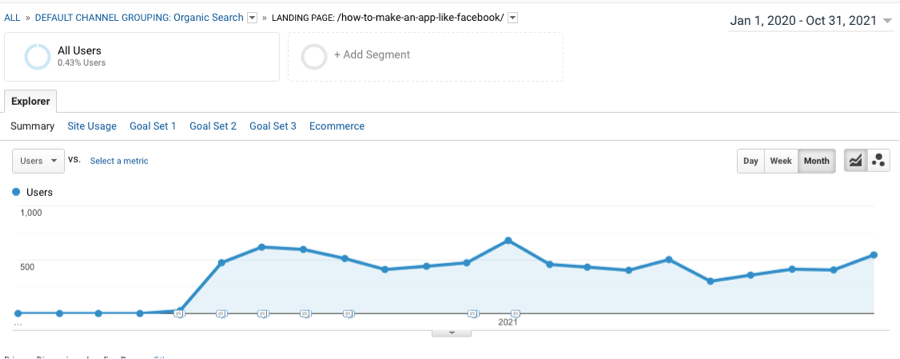
So far, the article got only 8009 users between January 2020 and October 2021. That’s is a great result considering that I used the first article as a baseline for this one and outsourced the entire content. The total cost for this article was no more than $100.
Considering only the searches from the USA, I would need to invest around $300 per month on Google Ad Words to get the traffic from the long-tail keywords from this article.
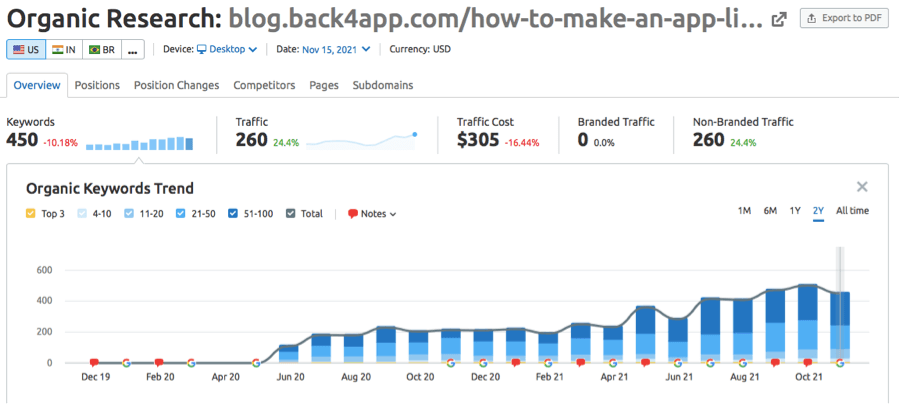
Considering this article has been running since June 2020, it would mean a $5,100 ( $300 x 17 months) on Ad Words. Investing $100 to rewrite the original content and adjusting it for the new long-tail keywords was an intelligent move.
The lesson learned is that it’s necessary to choose the keywords wisely. Want to go for high-competitive keywords? That is fine, but be aware the battle will be hard, and it will take a long time and resources to rank on the first page.
On the other hand, choosing easy-to-rank keywords with little competition will not bring as much traffic as a head keyword, but the odds of ranking on the first page are much higher.
At Back4app, we use SemRush to conduct keyword research. I have no idea how they benchmark all the metrics for a specific keyword, and the only thing I can say is that the tool works amazingly well (no, they are not paying me to say that).
Let’s consider this article as an example. The keywords I want to rank for are “content marketing for startups.” Here is a step-by-step guide on how to do it.
- Go to SemRush
- Keyword Magic Tool
- Get the keyword metrics
- Volume: 830
- Keyword Difficulty: 48%
- Requirements: A competitive keyword to rank for. You will need well-structured and unique content.
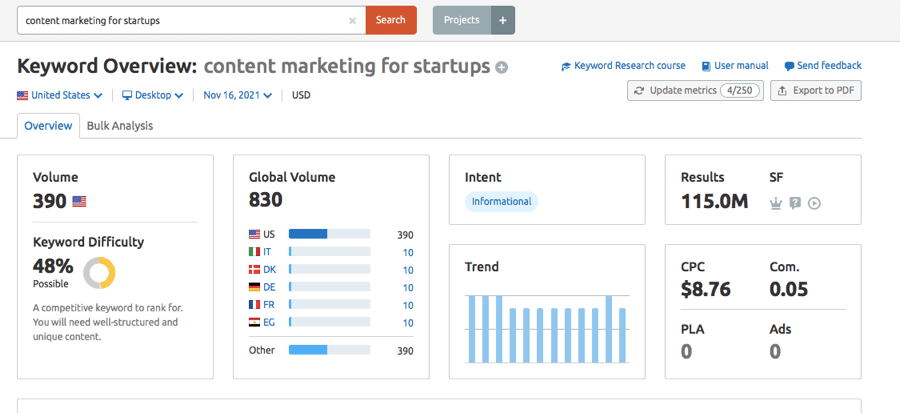
Based on these metrics, it’s possible to evaluate the chances to rank for this specific keyword. In this case, it will not be easy, but not impossible.
The advantages of this article are that it will be unique, provide high-quality content and share genuine experiences with the readers.
On the downside, it’s the first time I have published content related to digital marketing, and Google does not recognize Back4app as a brand with knowledge in this field.
Based on this analysis, I will take a chance and write the article mainly because I believe it will be helpful to the users and help other startups to scale content with real-life and not biased guidelines.
5. Translating your content is cheap and works like a charm
Translating your articles is a great way to scale marketing content! Creating original content is hard, but translating to other languages is a piece of cake.
At Back4app, we translate content to the following languages:
| Language | Why |
| Portuguese | I’m Brazilian, and it is my mother tongue. As simple as that. |
| Spanish | 4th most spoken language. English to Spanish translation is relatively cheap. |
| French | 5th most spoken language. The translation prices compared to Spanish cost almost twice, but France has a high GDP per capita, and customers convert well. |
| Russian | 8th most spoken language. English to Russian translation is relatively cheap. In addition, it allows Back4app to index on search engines like Yandex. |
| German | Costly translation, but Germany has a high GDP per capita e reasonable conversion rates. |
I use a platform called Fiverr to find translators. It provides a vast and knowledgeable freelancer database, and the payment process is straightforward. I like it very much.
There are two additional advantages of translating your content:
- You may rank on the translated article, even not ranking on the original one
- You start getting backlinks from a more diverse set of countries
It is vital to translate following the right SEO guidelines and informing Google about the translated content. Back4app uses the paid version of the plugin Polylang. It works great, is cost effective, and is easy to install.
6. Site speed really matters to Google
As you may know, Google started to use Web Vitals as a ranking factor in June 2021. So, site speed and page experience now play an essential role in Google’s ranking algorithm.
Back4app discovered that the hard way, and there is real-life data to show how important is the page experience for Google.
Take a look at the chart below. There is a growing trend between January and May. So far, so good, but do you see the 15% traffic drop in June? That’s WebVitals affecting Back4app’s general ranking.
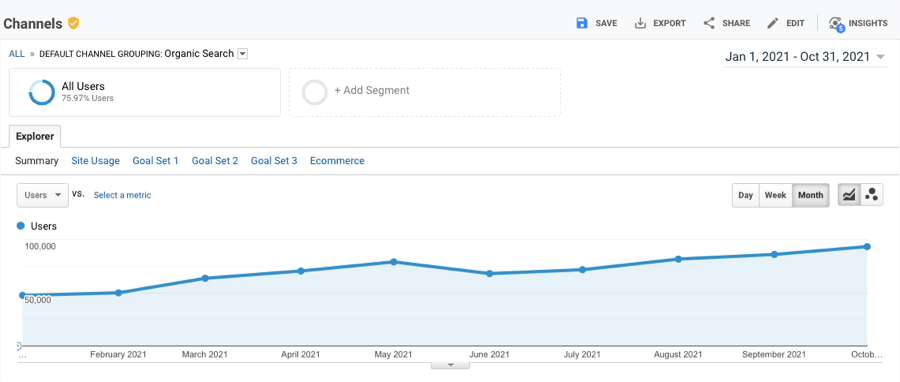
We recovered the traffic in August 2021, and below are the actions we took to improve Web Vitals metrics.
| Action | Difficulty Level | Results |
| Custom coding at the server level to improve the general speed of Word Press and website. | Very High | Great for the Word Press blog. Good for the website. |
| We changed our instance type on AWS for a best-in-class instance. We were using before a t2 old generation instance. We moved to an m5zn new and modern instance. | Medium | Great for the Word Press blog. We still have not implemented this action for the home page. |
| We reduced the size of all images of the blog. We used two tools for it: TinyPNG reSmush | Easy | Great for the Word Press blog. We still have not implemented this action for the home page. |
| We installed the Cloudflare APO plugin. It is designed to optimize site speed. | Medium | It works great for the Word Press blog. We still have not implemented this action for the home page. |
Implementing these actions took us around 30 days. The results were great, and all pages are now running with the Good on the Web Vitals console.
The traffic increase was pretty fast, and Google took around 30 days to identify better page speeds and increase our rankings.
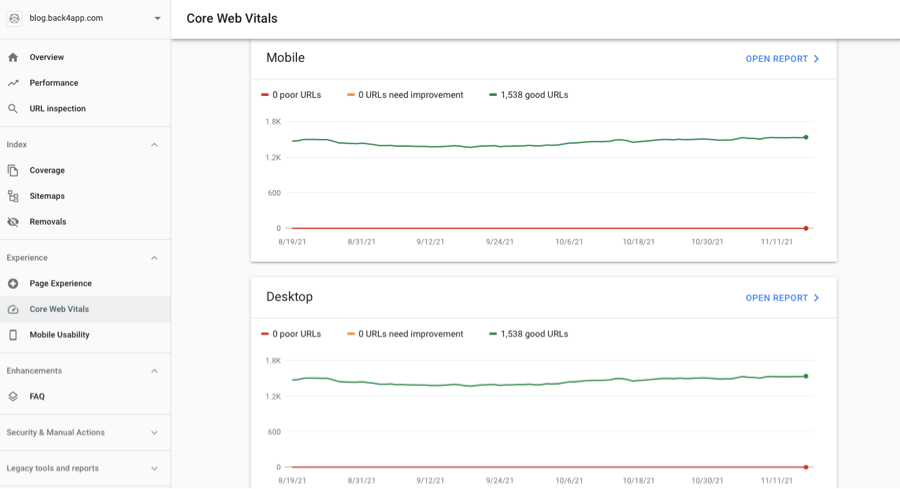
Below are some actions that we researched but did not implement. However, based on the research, they make a lot of sense for many companies.
- Running the Word Press blog on Kinsta
Based on a internal research, Kinsta seems to be one of the best Word Press hosting companies. I got great support from their team and was convinced they are one of the best options available for managed WP hosting.
However, Back4app decided to host the Word Press directly on AWS for the following reasons: (I) Lower costs (II) More control (III) We have a very experienced engineering team and deep expertise with hosting.
- Installing NitroPack
This solution seamlessly improves the website speed. In addition, it’s easy to install and integrate with the CDN services like Cloudflare. It is available for Word Press, Woo Commerce, and Magento.
We did not go for it mainly because we discovered the solution after implementing the actions specified in the table above. However, we tested the solution on a staging environment, and it improved the metrics. It was great, in particular for mobile page speed.
7. Backlinks, of course, help, but you can rank without them
Having tons of high-quality backlinks is, of course, better than not having it, but getting it in the right way may be challenging, in particular, for brand new websites.
The good news is that not necessarily pages need backlinks to rank for easy / long-tail keywords. Make sure you write awesome content, focus on your niche, and select the keywords carefully.
Don’t believe me? Here is an example:
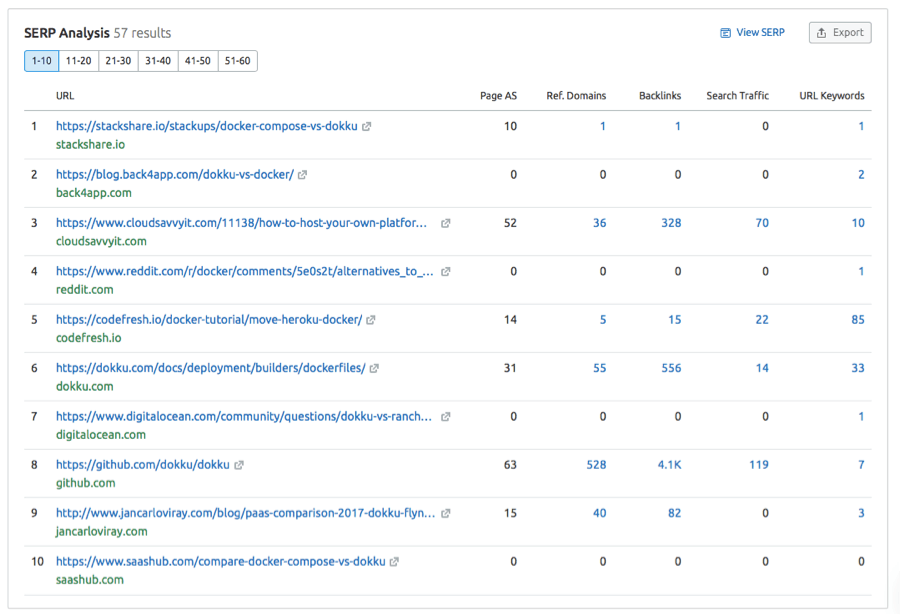
We published this article on October 31, 2021. Today is November 17, 2021. So, it took less than 20 days for Google to rank this article in the second position of the SERP. We made no promotion, and the article has no backlinks.
It is fascinating to see that the article on the third position has 328 backlinks and 36 domains referring to it. Back4app’s article ranked better because it was designed especially for one specific keyword and better solves the end user’s problem for this keyword in particular.
This strategy will most likely only work with easy to rank, long-tail, and few competitive keywords.
8. Easy to implement tactics to get backlinks
I want to share some tactics to increase the number of backlinks that we used on Back4app’s blog.
- Q&A on Quora
Quora is a social Questions and Answers website and according to ahrefs it has a Domain Rating of 91 out of 100.
Getting a backlink from Quora is pretty simple. You need to find a question related to the topic you are writing, answer the question with relevant information to the end-users, and add a backlink that makes sense.
No spam, please. Otherwise, Quora will moderate you.
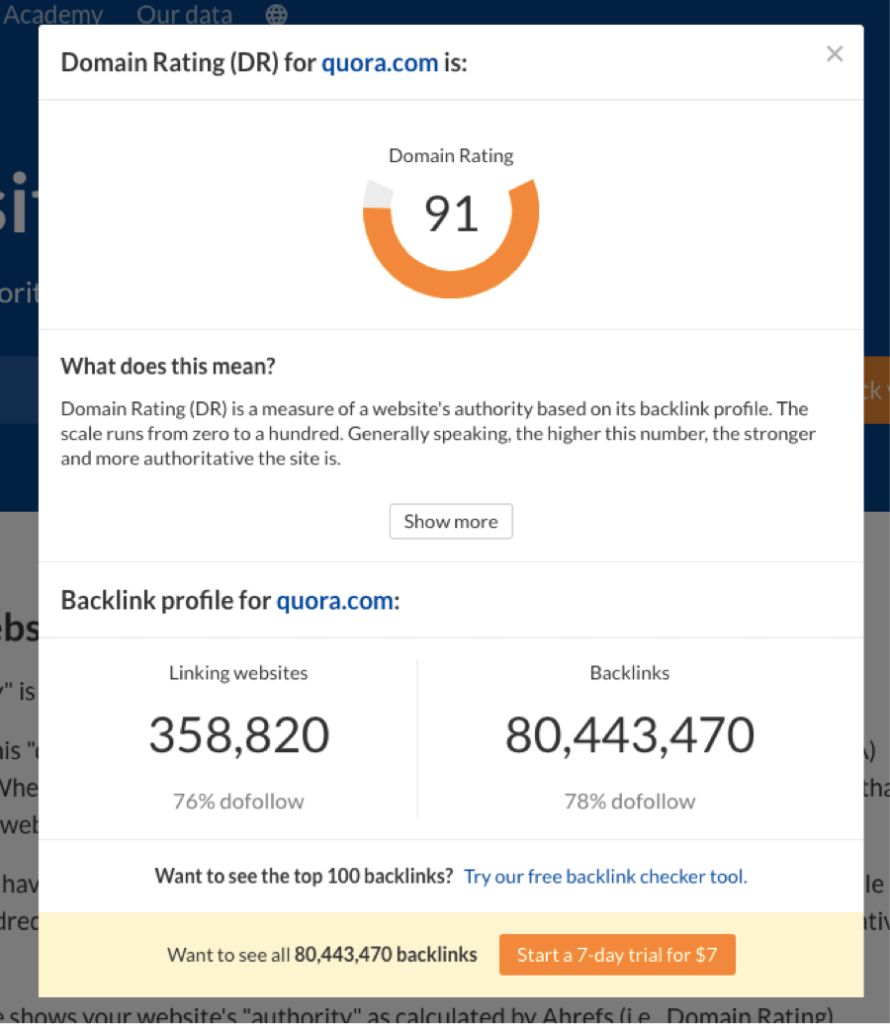
- Canonical articles on Medium
Medium is a publishing platform, and according to ahrefs it has a Domain Rating of 94 out of 100.
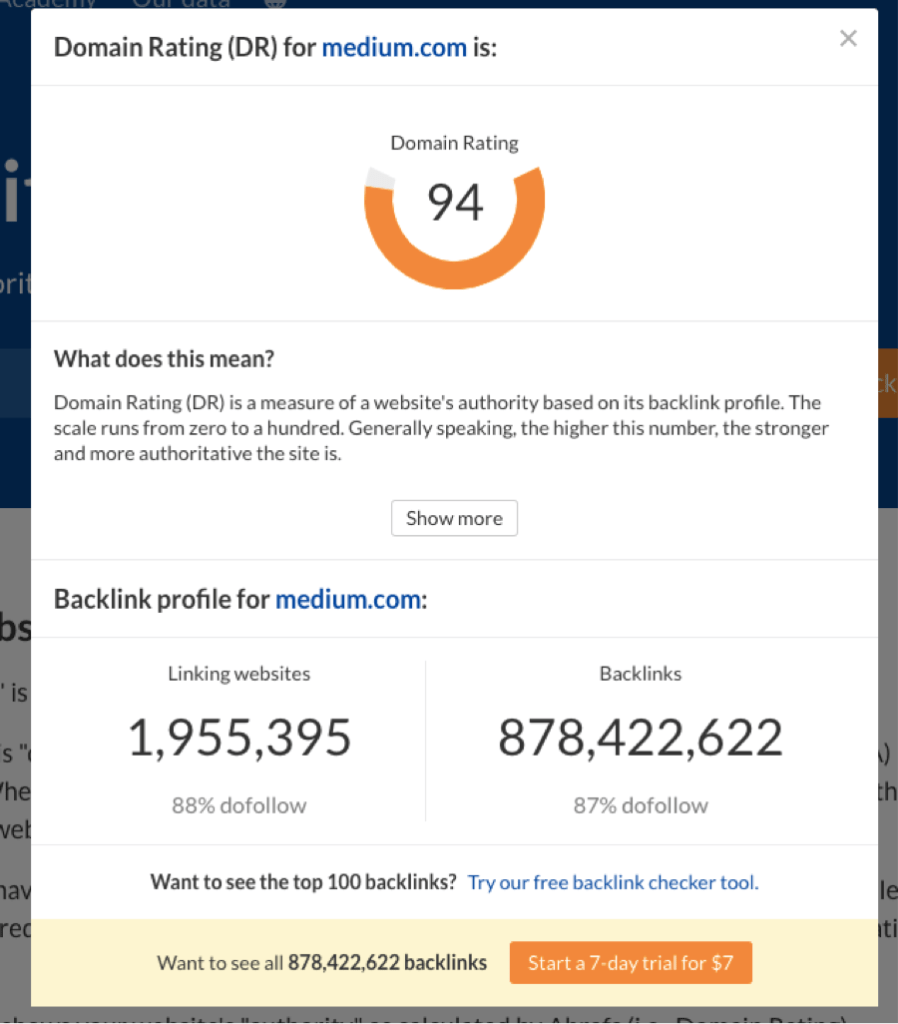
Importing a post on Medium is very simple, and they will add the canonical link automatically to guarantee the SEO is not penalized.
Making this step will make sure you get a high-quality backlink with almost no effort. There is no need to rewrite the content but import it to Medium.
- Conduct white hat outreach for your blog posts
This is a time-consuming activity but very effective. Unfortunately, at Back4app, we have no team to conduct outreach, and we outsource this activity.
We use a company called OnlineDoctors to conduct the work for us. They are very professional and deliver consistent results.
- Build free tools
This is a more sophisticated tactic but also very effective. At Back4app, we created a tool called Database Hub. This tool allows users to publish data in a structured way and open it to the internet.
Initially, we created a couple of databases by ourselves, and a few got excellent traction. A superb example is the Database of Continents, Countries, and Cities. Generally speaking, the user is able to connect to the database, fetch data for free using APIs, or download it under a JSON format.
This single URL brought us 113 backlinks from 68 different domains. We made no outreach campaign, and the entire process happened naturally. The other advantage of tools is a much higher conversation rate and lower bounce rate.

9. Technical SEO is very important
Besides page speed, many other factors are important for on-page SEO.
Some of them are:
- Crawlability – This relates to how efficiently Google can crawl a website and obtain the information it is looking for.
- Internal Linking – This relates to how great a site links between its pages.
- HTTPS – Evaluate issues associated with a website’s transformation from HTTP to HTTPS.
- International SEO – Incorporates the best practices for global websites and checks the utilization of the hreflang tag for general misuses and errors.
We use SemRush to measure our site health according to these metrics. The top-performing websites have site health above 92%.
10. Find a marketing guru to follow
I’m not a marketing person and have no previous experience in digital marketing. To date, I don’t even have an Instagram account and never used my Facebook account. So, if I learned some basics about marketing, you will be able to as well.
Before starting to publish articles on Back4app’s blog, I did extensive research about digital marketing. As a result, I consistently found great articles from Neil Patel.
I’m one of his email subscribers, and I have been following his tips since then. Neil Patel has a solid email marketing strategy, and most of the tactics described here I got from his writings or videos. I like it very much, and it was a good investment of my time.
The article I like most is 30 Lessons After 30 Million Users. It summarizes crucial lessons that are very effective in increasing organic flow.
Conclusion
This article explained how Back4app increased 12x the monthly organic traffic in less than 24 months and provided genuine tactics that are effective as an online marketing strategy for startups.
We learned that regularity in publishing content is the most critical aspect in increasing the organic flow. Also, writing top-notch content, defining a target audience, and focusing on a well-defined topic is a must-have for new blogs.
The great news is that it is possible to scale content marketing with minimal resources (we started with around $100/month). There is no need for a full-time marketing person, and you don’t have to be a marketer to implement the tactics described here.
I hope this article helps you to leverage your organic traffic and rankings on Google. If you have questions, please email me at [email protected].
PS: As you see below. Install also a FAQ plugin. It also helps to boost your rankings. I currently use the WPSC plugin.
FAQ
How to scale content marketing for a startup?
– Define a publishing pace and stick to it
– Write quality content and keep It updated
– Use effective SEO tools
– Focus on long-tail and easy to rank keywords
– Translate your content
– Improve your site speed
– Don’t over-stress about backlinks
– Get backlinks the right way
– Implement technical SEO
– Find a marketing guru to follow
What is the fastest way to rank on Google?
Based on my experience increasing the organic flow of Back4app’s blog from 8k users a month to 100k users a month, I would choose the right keywords, write great content, and focus on a niche.
Is page speed really important for Google?
Yes. Since June 2021, page speed and experience have been used as ranking factors. In addition, you can monitor your page results on Web Vitals.



